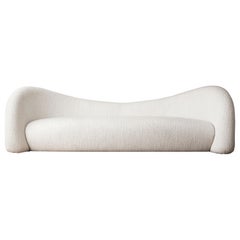Moon Navot
Recent Sales
21st Century and Contemporary French Modern Sofas
Wool, Foam, Wood
21st Century and Contemporary French Modern Sofas
Foam, Wood, Wool
A Close Look at modern Furniture
The late 19th and early 20th centuries saw sweeping social change and major scientific advances — both of which contributed to a new aesthetic: modernism. Rejecting the rigidity of Victorian artistic conventions, modernists sought a new means of expression. References to the natural world and ornate classical embellishments gave way to the sleek simplicity of the Machine Age. Architect Philip Johnson characterized the hallmarks of modernism as “machine-like simplicity, smoothness or surface [and] avoidance of ornament.”
Early practitioners of modernist design include the De Stijl (“The Style”) group, founded in the Netherlands in 1917, and the Bauhaus School, founded two years later in Germany.
Followers of both groups produced sleek, spare designs — many of which became icons of daily life in the 20th century. The modernists rejected both natural and historical references and relied primarily on industrial materials such as metal, glass, plywood, and, later, plastics. While Bauhaus principals Marcel Breuer and Ludwig Mies van der Rohe created furniture from mass-produced, chrome-plated steel, American visionaries like Charles and Ray Eames worked in materials as novel as molded plywood and fiberglass. Today, Breuer’s Wassily chair, Mies van der Rohe’s Barcelona chair — crafted with his romantic partner, designer Lilly Reich — and the Eames lounge chair are emblems of progressive design and vintage originals are prized cornerstones of collections.
It’s difficult to overstate the influence that modernism continues to wield over designers and architects — and equally difficult to overstate how revolutionary it was when it first appeared a century ago. But because modernist furniture designs are so simple, they can blend in seamlessly with just about any type of décor. Don’t overlook them.
Finding the Right settees for You
Vintage, new and antique settees are a smart and stylish choice for adding more seating to a room.
Settees first appeared in 17th-century Europe. A very famous settee, known as the Knole settee, was actually used by a monarch in South East England to receive visitors. This seating furniture was often part of a set that included matching chairs. While settees were popular in parlors, you could also find similar seating, such as daybeds and chaises longues (both of which derive from the settee, as does the chesterfield), where you might relax with guests in your home.
Today, a settee is still furniture that invites socializing. They’re common in living rooms and other shared areas because they allow you to cozy up to someone and have a conversation with them.
Settees are typically small seats that can fit two or more people, but they aren’t as wide as couches or sofas. A settee is more intimate and offers more sitting room than an armchair. Settees often have a backrest for optimal support and are frequently upholstered.
Are you looking to add more seating to an entertainment room but working with limited space? We promise that your vintage settee will look great next to your coffee table in your main seating area. You can also add a settee to your mudroom so that guests have a comfortable spot to sit down and take off their shoes. If you have a small space in your home that you’re still figuring out how to use, add a settee to turn it into a comfortable reading nook. They work in bedrooms too; a tufted settee designed by Danish modernist Finn Juhl makes perfect sense at the foot of your bed.
Most settees come with an upholstered seat, but you can find variations that aren’t upholstered. There are antique wood settees and benches that will look right at home in a rustic decor.
The backrest is an important consideration when choosing a settee. You can find pieces with low seat backs that look discreet and don’t provide a lot of support. If you want more support, we recommend choosing a settee with a high back.
A settee with a high back can become a statement piece, especially if you choose an item with a unique upholstery print or decorative frame.<a href=https://www.1stdibs.com/furniture/seating/settees/style/victorian/ target="_blank" rel="noopener noreferrer"> Victorian settees are ideal for introducing an air of sophistication to your living room. These pieces often feature frames of walnut or mahogany, a seat upholstered in chintz fabric (Victorians appreciated that the glazed finish made it easy to wipe clean) and sculptural hand-carved cabriole legs.
If you want something that feels more contemporary or will work better with your mid-century modern side tables and lounge chair, consider Space Age settees or mid-century modern versions. In your main seating area, tie the elements together with a large rug. (Find more tips on how to arrange furniture here.)
On 1stDibs, find a collection of vintage, new and antique settees from different eras to match any furniture style.

